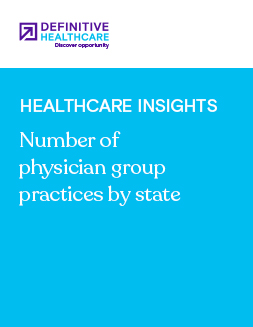Healthcare Insights
Top 25 most common ASC procedures by percent of total charges
Ambulatory surgery centers (ASCs) are among the fastest-growing segments of the outpatient care market, driven by their ability to offer surgical services at lower costs compared to hospitals. This cost-effectiveness is appealing to insurers, patients, and healthcare providers aiming to manage healthcare expenditures more efficiently. Advances in medical technology have also broadened the scope of procedures that can be safely performed in ASCs.
Using SurgeryCenterView, we compiled a list of the top 25 most common ambulatory surgery center procedures performed in 2023 and ranked them by percent of charges for all services made for that year. Understanding these procedure trends is crucial for companies navigating the dynamic landscape of outpatient healthcare, facilitating informed decision-making and strategic planning.
| Rank | HCPCS/CPT code | HCPCS/CPT description | % total charges | Average charge per procedure | Explore dataset |
|---|---|---|---|---|---|
| 1 | 66984 | Excision of cataract with removal of lens, without ECP | 8.5% | $3,867 | Explore |
| 2 | 45385 | Colonoscopy, with removal of lesion(s) | 4.3% | $2,009 | Explore |
| 3 | 45380 | Colonoscopy, with biopsy, single/multiple | 4.3% | $2,073 | Explore |
| 4 | 43239 | Esophagogastroduodenoscopy, biopsy, single/multiple | 3.9% | $1,806 | Explore |
| 5 | 45378 | Diagnostic colonoscopy | 2.3% | $1,949 | Explore |
| 6 | 64483 | Injection(s), anesthetic agent and/or steroid, lumbar/sacral | 1.3% | $2,473 | Explore |
| 7 | 812 | Anesthesia for lower intestine scope, colonoscopy | 0.9% | $974 | Explore |
| 8 | 64493 | Injection(s), anesthetic agent and/or steroid, lumbar/sacral | 0.9% | $2,517 | Explore |
| 9 | 64635 | Destruction of lumbar/sacral facet joint(s) by neurolytic | 0.9% | $3,973 | Explore |
| 10 | 69436 | Incision of eardrum to create opening | 0.8% | $3,366 | Explore |
| 11 | 142 | Anesthesia for lens surgery | 0.7% | $772 | Explore |
| 12 | 811 | Anesthesia for lower intestine endoscopy, not otherwise spec. | 0.6% | $1,013 | Explore |
| 13 | G0121 | Screening colonoscopy, not high risk individual | 0.6% | $1,750 | Explore |
| 14 | 62323 | Injection, interlaminar lumbar/sacral spine, epidural | 0.6% | $2,003 | Explore |
| 15 | 731 | Anesthesia for upper gastrointestinal endoscopy, not otherw. | 0.5% | $1,129 | Explore |
| 16 | 813 | Anesthesia for upper and lower GI endoscopy, not otherwise sp. | 0.5% | $1,294 | Explore |
| 17 | C1713 | Anchor/screw, bone/bone, tissue/bone | 0.5% | $1,519 | Explore |
| 18 | G0105 | Colorectal cancer screening, high risk individual | 0.5% | $1,539 | Explore |
| 19 | 64494 | Injection(s), anesthetic agent and/or steroid, lumbar/sacral | 0.5% | $1,900 | Explore |
| 20 | 66821 | Posterior chamber lens surgery after cataract removal | 0.4% | $1,054 | Explore |
| 21 | 99214 | Office or other outpatient visit, established patient, 30 min | 0.2% | $277 | Explore |
| 22 | 99213 | Office or other outpatient visit, established patient, 20 min | 0.1% | $191 | Explore |
| 23 | G8907 | Patient had no events on discharge | 0.0% | $0 | Explore |
| 24 | G8918 | Patient without preoperative ordered intravenous antibiotics | 0.0% | $0 | Explore |
| 25 | 36415 | Routine venipuncture | 0.0% | $11 | Explore |
Fig. 1 – Data is from the Definitive Healthcare Atlas All Payor Claims Dataset for the calendar year 2023. Claims data is sourced from multiple medical claims clearinghouses in the United States and is updated monthly. Data accessed June 2024.
Which ASC procedures have the most charges?
The procedure with the highest percentage of total charges in 2023 is extracapsular cataract removal without endoscopic cyclophotocoagulation (CPT code 66984), which accounted for 8.5% of charges at ambulatory surgery centers in the U.S. This procedure involves the removal of a cataract and implantation of an artificial intraocular lens (IOL), often using advanced techniques or specialized devices not typical in routine cataract surgery.
Following closely is CPT code 45385, describing a colonoscopy with removal of lesion(s), which represented 4.3% of ASC charges. This procedure involves using a flexible tube with a camera to examine and remove lesions from the colon, aiding in the diagnosis and treatment of various gastrointestinal conditions such as colorectal cancer, polyps, and inflammation.
Next is CPT code 45380, describing a colonoscopy with biopsy, single or multiple, which also accounted for 4.3% of ASC charges. This procedure uses a flexible tube with a camera to examine the colon's inner lining and take tissue samples for biopsy, aiding in diagnosing various gastrointestinal conditions.
What surgeries are performed in an ASC?
ASCs can perform a wide range of surgical procedures that do not involve complex interventions or prolonged recovery times. Some surgeries performed in ASCs include:
- Orthopedics: Arthroscopic procedures for the knee, shoulder, or other joints, and carpal tunnel release
- Ophthalmology: Cataract surgery, corneal procedures, and other eye surgeries
- Gastroenterology: Colonoscopy, endoscopy, and certain types of hernia repairs
- Ear, nose, and throat (ENT): Tonsillectomy, adenoidectomy, and sinus surgery
- Cosmetic surgeries: Rhinoplasty, blepharoplasty, and abdominoplasty
- Urology: Prostate biopsies, kidney stone removal, and cystoscopy
- Gynecology: Tubal ligation, endometrial ablation, and cervical biopsy
- Podiatry: Bunion surgery, ingrown toenail removal, and other foot and ankle procedures
Who can own an ambulatory surgery center?
Ownership of ambulatory surgery centers varies based on state regulations and federal laws. Generally, the following entities or individuals can own ASCs:
- Physicians: Many ASCs are owned wholly or in part by physicians, including surgeons and specialists who perform procedures at the center.
- Hospitals: Hospitals may own ASCs either independently or through joint ventures with physicians or other entities. Hospital-owned ASCs can benefit from economies of scale, shared resources, and integrated care models.
- Health systems and IDNs: Larger healthcare systems and IDNs often own ASCs as part of their broader network of healthcare facilities. This ownership structure allows for coordinated care and seamless patient referrals between ASCs and other healthcare services within the system.
- Corporate entities: Some ASCs are owned by corporate entities that specialize in healthcare management or outpatient surgery services. These entities may operate multiple ASCs across different regions or specialties.
- Joint ventures: ASC ownership can also be structured as joint ventures between physicians, hospitals, health systems, or corporate entities. Joint ventures allow for shared investment, risk, and governance among the participating parties.
- Management companies: Management companies specializing in ASC operations may manage and operate ASCs on behalf of physician groups, hospitals, or corporate owners. These companies provide expertise in regulatory compliance, operational efficiency, and financial management.
Ownership rules and regulations can vary significantly by state, and compliance with federal laws, such as the federal Stark Law and Anti-Kickback Statute, is crucial for structuring ownership arrangements involving referrals and financial relationships between physicians and ASCs. As such, ownership of ASCs is typically structured to comply with these regulatory frameworks while promoting quality care and efficiency in outpatient surgical services.
Learn more
Healthcare Insights are developed with healthcare commercial intelligence from the Definitive Healthcare platform. Want even more insights? Start a free trial now and get access to the latest healthcare commercial intelligence on hospitals, physicians, and other healthcare providers.



